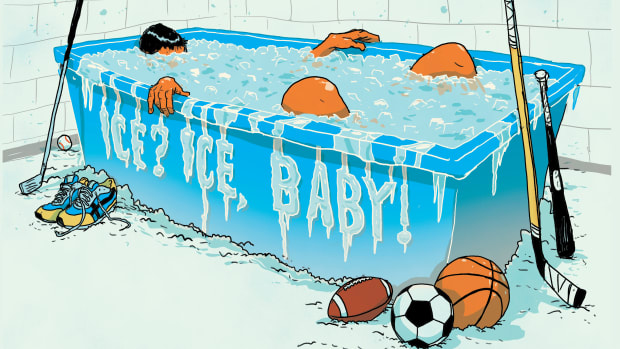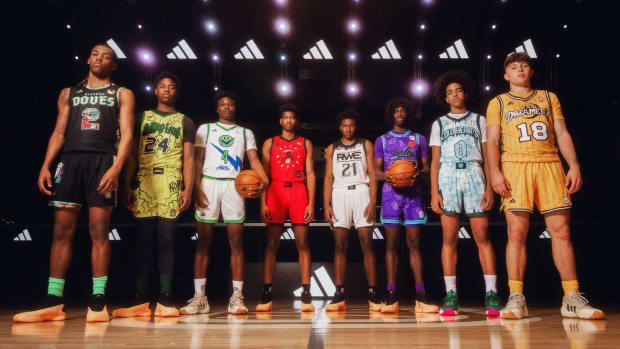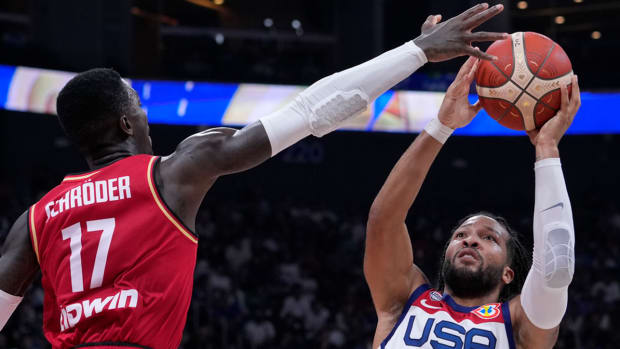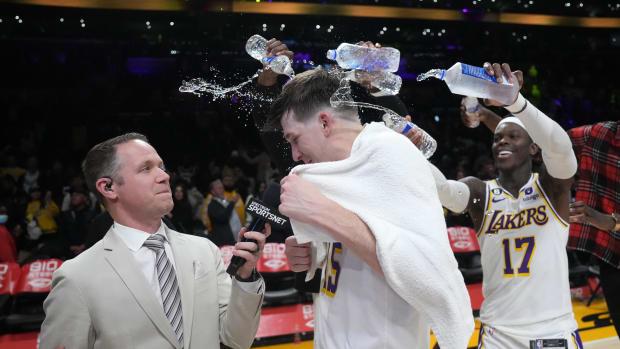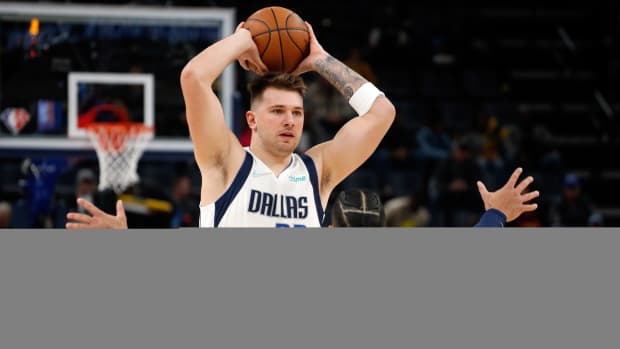Roosevelt Purvis slips a white 3M mask over his dreadlocks and Yankees hat as he ambles along East 143rd Street in the Mott Haven section of the Bronx. Lincoln Hospital is two blocks away. Sirens mix with birdsong.
Purvis, 59, is in the epicenter of a pandemic. The coronavirus and its consequences are clear to him. His godson, Lee Green, a former St. John’s basketball player who went on to join the New York City Police Department, was one of the earliest victims in the borough. Purvis thumbs a remembrance card. His friend—more like a brother than a godson—was 49.
“Neighborhood hero!” Purvis says, rattling off Lee’s résumé. “Tolentine High! Cheshire Academy! St. John’s!”
Blue rubber gloves line the path on Purvis’s walk to Building No. 281 in the Patterson Houses, a wedge of 15 towering low-income units, a short jump from Yankee Stadium. Inside, leaflets dot the hallway walls: WHAT NEW YORKERS NEED TO KNOW ABOUT COVID-19. Purvis retraces the route he used to walk each day as a teenager, aiming to wake up Green, who lived in Apartment 1A. Today, he eyes Green’s old window.
“Yo, Lee!” Purvis hollers, mimicking his old order. “Throw the ball out [so I can] get the court!”
Outside lies a patch of fenced-in asphalt—Patterson Square Garden to those who know. Green grew up shooting here. When it snowed, the boy with the big feet pulled on his father’s sneakers and pushed a shovel to clear the court. In the summer, he competed with all comers, negotiating his way to the basket with elbows-out aggressiveness. “I can still hear his laugh,” says Purvis.
That laugh will never leave Purvis. It meant that Green, a lefty, was trying to time a block on one of his right-handed layups. He sighs. “Lee used to [swat] my ball over that fence, and off parked cars. I went harder and stronger each time. Same result. Always protecting that rim.”
* * *
New Yorkers are known, widely, for their ability to keep a dribble alive, no matter the obstacle. But COVID-19 brought an abrupt cessation to the city game in March. As the daily death count rose, Mayor Bill de Blasio embraced an escalation of social distancing. People were encouraged to stay six feet apart. Parks were closed. When that didn’t seem enough, more than 2,100 rims were removed by teams of maintenance workers across the metropolis, with rare exception. Like Green's death, it was a reminder that the virus can touch anyone.
From Washington Heights to West Fourth Street, the steel rings have been unscrewed. All 10 rims are down at the Foster Avenue Park in Flatbush, where Rick Telander filled his notebook for Heaven Is a Playground, an ode to the outdoor game, with all of its native vice and grace. Any respectable athlete could clear the metal barricades that block two entrances to Holcombe Rucker Park on 155th Street in Harlem, but inside there are no rims to shoot on. Rusty chains are wrapped around iron gates at another entrance, a Master Lock resting atop the links. The lone sound emanating from inside that playground: a rope rattling against a flagpole in the wind.
These rims were built to last, constructed for the opposite of hasty removal. John Fitzgerald and his team of Parks Department blacksmiths forged many of them and affixed them to inimitable metal backboards, long before the era of prefabricated rims. Handmade with a hammer and anvil’s horn, these classic rims are a staple of New York City schoolyards and playgrounds, but beneath them the games vary. Three-on-three in the half court or five-on-five full court. Some play straight up on a miss; others require a take back to the foul line. One man’s game of “21” is known to another as “Animal.” Numbers are all that matter, and everyone knows the golden rule: Winners stay on.
Urbanites have long held love-hate relationships with these courts. Vagaries abound. There are rims with no backboards, backboards with no rims. Nets are considered a luxury, and shooters have to account for uneven asphalt, knowing which rims are bent or loose. To combat those concerns, a premium is placed on ballhandling. Aggressive drives to the lane are encouraged. Lori Lightfoot, the mayor of Chicago, knew her audience when she chastised children still playing in her own city’s parks last week. She issued the trash talk on Twitter: “Your jump shot is always gonna be weak. Stay out of the parks.”
In New York, though, innovation thrives. It will take more than a wrench or a crack on Twitter to halt the launching of high-arching threes and running dunk attempts. In Bedford-Stuyvesant, milk crates with their bottoms cut out rest affixed to wooden planks on one block; alternate-side parking signs have been replaced by backboards and rims on another. In Crown Heights, a Hasidic family has hung a rim from its fire escape, over its building’s front door on Empire Boulevard; children in yarmulkes reach up for it as they come and go each day.
There is one corner of the city, at least, where lights still come on at dusk: at the Hole, a sunken court in the middle of the Van Dyke Houses of Brownsville, on the eastern side of Brooklyn. Fly Williams, a star at Austin Peay in the 1970s, used to hold court there, and the kids still come out to hone their ballhandling after long days spent inside. Now, though, they exercise social distancing, taking turns running dribbling drills, up and down the court.
“The kids are getting the message,” says Darryl Glenn, a fixture at the Brownsville Recreation Center. “We have to let them know: It’s for their safety.”
* * *
A rebound is coming. At Patterson Square Garden, where Lee Green grew up timing Roosevelt Purvis’s shot, there is, literally, no court at the moment. City workers broke up the asphalt months ago; right now the court is a construction site. Nearby, a work permit notes that, after the excavation—after the epidemic—a new court will be laid, with fresh rims. “We’ve been waiting a while for this,” says Purvis. “There was progress—until this whole mess.”
In the interim, he mourns his godson. He knows Lee was deejaying at a gathering of old basketball friends in Scarsdale, N.Y., 10 days before he died. Six people at that party were infected with the coronavirus. Lee was one of two who passed away, according to The New York Times.
Purvis recalls Green’s love for mixing music with basketball. “When you walked in the room, he always had his equipment out and balls all around,” he says. Today, though, sirens provide the soundtrack for the block as ambulances rush to Lincoln Hospital, around the corner. Death, seemingly, is everywhere.
There was a quiet, lightly attended service for Green recently, at Granby’s Funeral Home on White Plains Road. Purvis circles his old battleground, mid-revamp, and weighs his grief. A send-off without the constraints of quarantine is in order, he says, when family members and friends are free to share their memories.
“We supposed to get together again. There will be some crying.”






